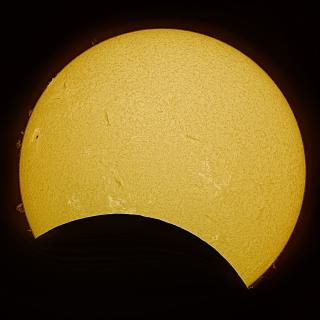It may interest you
-
 This Saturday, 29 March 2025, the Instituto de Astrofísica de Canarias (IAC) was able to follow the partial solar eclipse from the Teide Observatory in Tenerife. Although subtle to the naked eye, this eclipse was used by the IAC's outreach team to raise awareness of the phenomenon among a group of people from the ‘Friends of the IAC’ programme and IAC staff. At the same time, an observation was also made from the IAC Headquarters in La Laguna, which could be seen live on the centre's YouTube channel. The eclipse began at 09:14 UT and ended at 10:56 UT, with its maximum at 10:03 UT. For justAdvertised on
This Saturday, 29 March 2025, the Instituto de Astrofísica de Canarias (IAC) was able to follow the partial solar eclipse from the Teide Observatory in Tenerife. Although subtle to the naked eye, this eclipse was used by the IAC's outreach team to raise awareness of the phenomenon among a group of people from the ‘Friends of the IAC’ programme and IAC staff. At the same time, an observation was also made from the IAC Headquarters in La Laguna, which could be seen live on the centre's YouTube channel. The eclipse began at 09:14 UT and ended at 10:56 UT, with its maximum at 10:03 UT. For justAdvertised on -
 The Instituto de Astrofísica de Canarias (IAC) is joining the Earth Hour, a global movement that, once a year, reminds us that nature is the planet’s life support and highlights the environmental emergency that requires collective action.Advertised on
The Instituto de Astrofísica de Canarias (IAC) is joining the Earth Hour, a global movement that, once a year, reminds us that nature is the planet’s life support and highlights the environmental emergency that requires collective action.Advertised on -
 El proyecto educativo “CosmoLab: del aula al Sistema Solar”, desarrollado por el Instituto de Astrofísica de Canarias (IAC) y financiado principalmente por el Cabildo de Tenerife, anuncia la apertura de matrícula del nuevo curso “CosmoViaje 2.0: lo que sabemos e ignoramos del Universo” en colaboración con la Consejería de Educación del Gobierno de Canarias. Esta iniciativa busca acercar la astronomía a toda la comunidad educativa de Tenerife y fomentar el conocimiento y disfrute de los excepcionales cielos y observatorios de Canarias. CosmoLab persigue promover la cultura científica en elAdvertised on
El proyecto educativo “CosmoLab: del aula al Sistema Solar”, desarrollado por el Instituto de Astrofísica de Canarias (IAC) y financiado principalmente por el Cabildo de Tenerife, anuncia la apertura de matrícula del nuevo curso “CosmoViaje 2.0: lo que sabemos e ignoramos del Universo” en colaboración con la Consejería de Educación del Gobierno de Canarias. Esta iniciativa busca acercar la astronomía a toda la comunidad educativa de Tenerife y fomentar el conocimiento y disfrute de los excepcionales cielos y observatorios de Canarias. CosmoLab persigue promover la cultura científica en elAdvertised on
